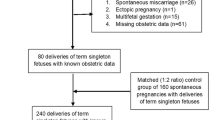Abstract
Purpose
To evaluate factors associated with interpregnancy interval (IPI) among women treated with in vitro fertilization (IVF).
Methods
Women with at least two cycles of IVF between 2004 and 2013 were identified from the SART CORS database and grouped by age at first cycle, infertility diagnosis, IVF treatment parameters, and cycle 1 outcome (singleton or multiple live birth or no live birth, length of gestation, and birthweight). The distributions of IPIs (in months, 0–5, 6–11, 12–17, 18–23, and ≥ 24) were compared across these factors. IPI was fit as a function of these factors by a general linear model, separately for singleton and multiple live births and no live births at cycle 1.
Results
The study included 93,546 women with two consecutive IVF cycles where the first cycle resulted in a clinical intrauterine pregnancy or a live birth. Among women with a live birth in cycle 1, there was a general pattern of longer IPI for younger women compared to older women. Women with a multiple birth waited longer before initiating a second cycle than women with a singleton birth. For women with no live birth in the first cycle, nearly three fourths initiated cycle 2 within 6 months, regardless of their age. Short (0–5 months) IPI was associated with preterm delivery, older maternal age, and use of donor oocytes.
Conclusions
Age of the mother, outcome of the first pregnancy, and treatment factors affect the length of the interpregnancy interval. Because short IPI has been associated with poor outcomes, women who are at risk for short IPI should be counseled about these outcome risks.
Similar content being viewed by others
Change history
06 September 2018
The original version of this article unfortunately contained a mistake. The name of an investigator was incorrectly listed as M. B. Morton, instead of M. B. Brown.
References
Conde-Agudelo A, Rosas-Bermúdez A, Kafury-Goeta AC. Birth spacing and risk of adverse perinatal outcomes: a meta-analysis. JAMA. 2006;295(15):1809–23.
Zhu BP, Rolfs RT, Nangle BE, Horan JM. Effect of the interval between pregnancies on perinatal outcomes. N Engl J Med. 1999;340(8):589–94.
Hegelund ER, Urhoj SK, Andersen AMN, Mortensen LH. Interpregnancy interval and risk of adverse pregnancy outcomes: a register-based study of 328,577 pregnancies in Denmark in 1994–2010. Matern Child Health J. 2018;22:1008–15. https://doi.org/10.1007/s10995-018-2480-7.
Shree R, Caughey AB, Chandrasekaran S. Short interpregnancy interval increases the risk of preterm premature rupture of membranes and early delivery. J Matern Fetal Neonatal Med. 2017:1–7. https://doi.org/10.1080/14767058.2017.1362384.
Conde-Agudelo A, Rosas-Bermúdez A, Kafury-Goeta AC. Effects of birth spacing on maternal health: a systematic review. Am J Obstet Gynecol. 2007;196:297–308. https://doi.org/10.1016/j.ajog.2006.05.055.
Grundy E, Kravdal Ø. Do short birth intervals have long-term implications for parental health? Results from analyses of complete cohort Norwegian register data. J Epidemiol Community Health. 2014;68(10):958–64. https://doi.org/10.1136/jech-2014-204191.
Pandey S, Shetty A, Hamilton M, Battacharya S, Maheshwari A. Obstetric and perinatal outcomes in singleton pregnancies resulting from IVF/ICSI: a systematic review and meta-analysis. Hum Reprod Update. 2012;18(5):485–503. https://doi.org/10.1093/humupd/dms018.
Yang J, Baer RJ, Berghella V, Chung P, Coker T, Currier RJ, et al. Recurrence of preterm birth and early term birth. Obstet Gynecol. 2016;128(2):364–72. https://doi.org/10.1097/AOG.0000000000001506.
Acknowledgements
The authors wish to thank SART and all of its members for providing clinical information to the SART CORS database for use by patients and researchers. Without the efforts of their members, this research would not been possible.
Author information
Authors and Affiliations
Corresponding author
Ethics declarations
This study was approved by Institutional Review Board of the Michigan State University.
Additional information
The original version of this article was revised: One of the author's name is incorrect, M. B. Morton, instead of M. B. Brown.
Rights and permissions
About this article
Cite this article
Amrane, S., Brown, M.B., Lobo, R.A. et al. Factors associated with short interpregnancy interval among women treated with in vitro fertilization. J Assist Reprod Genet 35, 1595–1602 (2018). https://doi.org/10.1007/s10815-018-1261-y
Received:
Accepted:
Published:
Issue Date:
DOI: https://doi.org/10.1007/s10815-018-1261-y




